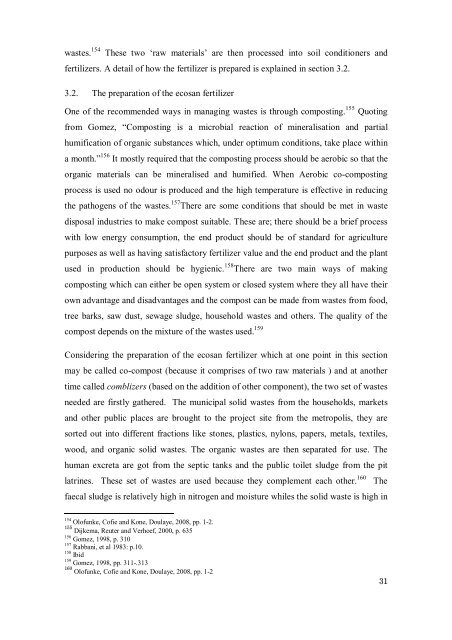A QUANTITATIVE APPROACH TO PREDICT ... - SuSanA
A QUANTITATIVE APPROACH TO PREDICT ... - SuSanA
A QUANTITATIVE APPROACH TO PREDICT ... - SuSanA
You also want an ePaper? Increase the reach of your titles
YUMPU automatically turns print PDFs into web optimized ePapers that Google loves.
wastes. 154 These two ‘raw materials’ are then processed into soil conditioners and<br />
fertilizers. A detail of how the fertilizer is prepared is explained in section 3.2.<br />
3.2. The preparation of the ecosan fertilizer<br />
One of the recommended ways in managing wastes is through composting. 155 Quoting<br />
from Gomez, “Composting is a microbial reaction of mineralisation and partial<br />
humification of organic substances which, under optimum conditions, take place within<br />
a month.” 156 It mostly required that the composting process should be aerobic so that the<br />
organic materials can be mineralised and humified. When Aerobic co-composting<br />
process is used no odour is produced and the high temperature is effective in reducing<br />
the pathogens of the wastes. 157 There are some conditions that should be met in waste<br />
disposal industries to make compost suitable. These are; there should be a brief process<br />
with low energy consumption, the end product should be of standard for agriculture<br />
purposes as well as having satisfactory fertilizer value and the end product and the plant<br />
used in production should be hygienic. 158 There are two main ways of making<br />
composting which can either be open system or closed system where they all have their<br />
own advantage and disadvantages and the compost can be made from wastes from food,<br />
tree barks, saw dust, sewage sludge, household wastes and others. The quality of the<br />
compost depends on the mixture of the wastes used. 159<br />
Considering the preparation of the ecosan fertilizer which at one point in this section<br />
may be called co-compost (because it comprises of two raw materials ) and at another<br />
time called comblizers (based on the addition of other component), the two set of wastes<br />
needed are firstly gathered. The municipal solid wastes from the households, markets<br />
and other public places are brought to the project site from the metropolis, they are<br />
sorted out into different fractions like stones, plastics, nylons, papers, metals, textiles,<br />
wood, and organic solid wastes. The organic wastes are then separated for use. The<br />
human excreta are got from the septic tanks and the public toilet sludge from the pit<br />
latrines. These set of wastes are used because they complement each other. 160 The<br />
faecal sludge is relatively high in nitrogen and moisture whiles the solid waste is high in<br />
154 Olofunke, Cofie and Kone, Doulaye, 2008, pp. 1-2.<br />
155 Dijkema, Reuter and Verhoef, 2000, p. 635<br />
156 Gomez, 1998, p. 310<br />
157 Rabbani, et al 1983: p.10.<br />
158 Ibid<br />
159 Gomez, 1998, pp. 311-.313<br />
160 Olofunke, Cofie and Kone, Doulaye, 2008, pp. 1-2<br />
31
















